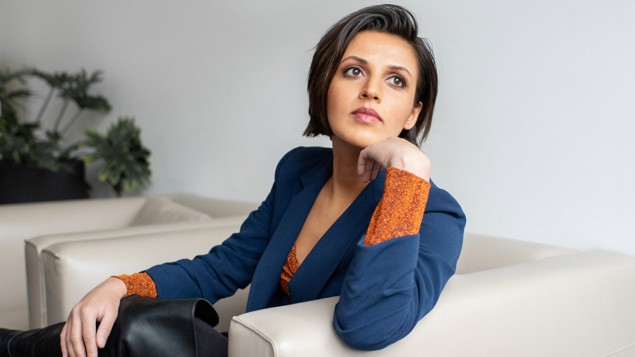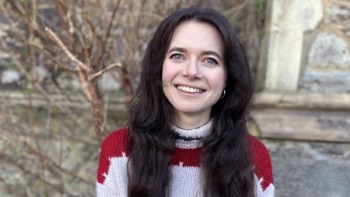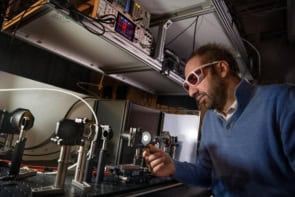Prineha Narang, a physicist at UCLA who works at the intersection of condensed matter and quantum physics, tells Rob Lea about the challenges of defining yourself as a researcher, why she still puts fun at the forefront of her work, and what scientists can learn from distance running

When she was in middle school in the US between the ages of 11 and 14, Prineha Narang wasn’t planning on becoming a physicist. As a sporty preteen, her attention was instead on the running track. “I was convinced that I was going to do something athletic. I had always been good in my math and science courses, but I’d never really thought of that as a career,” Narang explains. “It was actually a track coach who gently pushed me towards STEM (science, technology, engineering and mathematics) saying, ‘You’re good at running, but I hear you’re really good at math and science.’”
The coach’s comment would seem to be justified. Narang went on to do a PhD in applied physics at Caltech, and after postdoctoral positions at Harvard University and the Department of Physics at MIT, she joined the faculty at Harvard in 2017. But she says there wasn’t a single defining moment where she realized she was destined for a career in physics, describing her trajectory as a gradual progression.
Now Narang runs a group at the University of California Los Angeles (UCLA) where she researches non-equilibrium materials science – controlling quantum matter and quantum systems using external drives like lasers or electron beams. The work of the NarangLab spans areas of physics, chemistry, computing and engineering.
Writing your own rules
Narang says that her journey to define herself and her research has not been seamless. She notes that there was a lack of programmes focused on undergraduate women in physics, and little support for women in the field, adding that perhaps this inequality was something that hadn’t been identified as a problem at that time.
“One of the challenges was finding someone who could help me find my way through all of the different things you could do in this field, as I recognized that there weren’t that many female faculty members to assure me that I belonged there,” Narang says. “That kind of a question remarkably went away when I became a graduate student at Caltech and had incredibly supportive mentors, both in my own research as well as others on the faculty.”
In our group, we have embraced this interdisciplinary approach
Another challenge Narang faced came after she had become a full faculty member. She had to decide what her research area would be and how it would fit in the broader sphere of physics. The work of the NarangLab is hard to fit into a box, but that’s exactly how she likes it. “In our group, we have embraced this interdisciplinary approach,” Narang explains. “We think about how you can bring together condensed matter and optics, how you can bring together device physics – and make this happen in a synergistic manner.”
Staying curious
Narang’s research has received many awards, including the 2023 Maria Goeppert Mayer Award from the American Physical Society and a 2023 Guggenheim Fellowship in Physics. She was also recently selected as a United States Science Envoy. But she says there’s a surprising secret to her work. “The focus of the group is doing excellent science while having fun,” she explains. “That’s something that we emphasize a lot, and it comes from my own experience in science. I want people to feel that excitement when working on a topic, especially when they have a new result.”
I get a lot of satisfaction out of communicating the science that we’re doing because I’m excited about it
Narang applies the same enthusiasm when communicating their results. She adds that this is particularly important when disseminating ideas that aren’t easily accessible, such as those that the team works with every day. “I think it’s really important to go out there and make that effort,” Narang says. “I get a lot of satisfaction out of communicating the science that we’re doing because I’m excited about it, and I feel like if I could get other people to see it the way I do, they would be excited about it, too.”
Life lessons
Narang doesn’t let doing and talking about exciting physics stop her from outdoor pursuits like mountain climbing and running – and though this may just be a hobby today, her early interest in athletics has resulted in life experience that she carries over to her career.

Rethinking physics: Silvia Vignolini on succeeding at the boundary between disciplines
“I still run. Science has a lot in common with distance running. For example, the most important thing is actually to get out there and run and continue to try,” Narang says. “Some days are amazing, and other days you feel like, ‘Oh my gosh, that crushed me’. It kind of feels the same with the science.”
Narang adds that the key to overcoming this feeling in both long-distance running and in science is the determination to push through feelings of despondency. “Something I try to convey to junior scientists is that not everything needs to come to you instantly,” Narang concludes. “It can be a long road, and that’s okay.”


